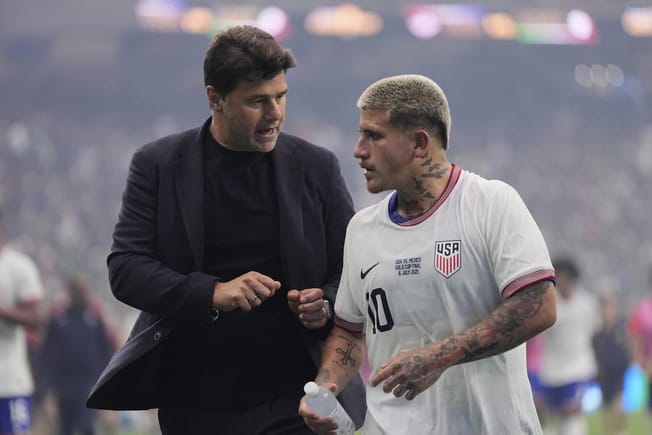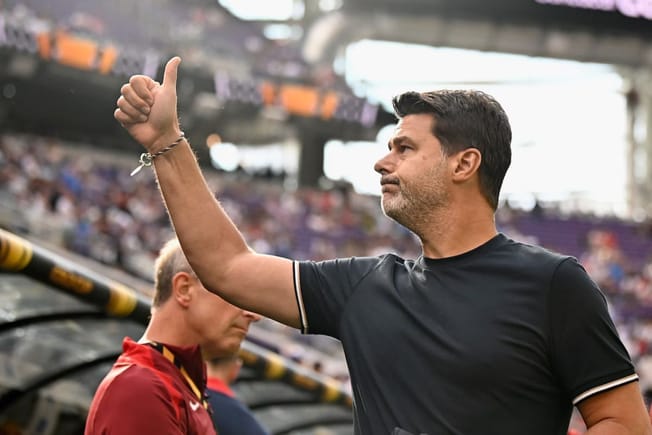One of my favorite things about this period leading up to the World Cup is getting to watch and really learn more about the U.S. men’s national team. And we did learn a few things on Wednesday night during the USMNT’s 3-0 win over Morocco in Cincinnati.
The game was closer than the scoreline indicates, but the U.S. still accomplished some useful things.
In my 5 questions, 5 answers piece that published at full-time, I wrote that the U.S. passed the test against Morocco. They didn’t pass simply because they won, though that does help the narrative. No, the USMNT passed because they got their healthy core players on the field tougher, tried out some new faces, and added a little tactical wrinkle to make it more difficult for opposing teams to scout them ahead of the World Cup.
Let’s talk a bit more about that tactical wrinkle, shall we? Plus, I’ll get to a handful of other things that we learned from the United States’ 3-0 win.
BERHALTER IS WILLING TO CHANGE THINGS UP
Gregg Berhalter wasn’t kidding. Coming into the June, the U.S.’s head coach said that he was going to use at least some of this international window to work on a back three.
That’s exactly what we saw from the USMNT in possession on Wednesday.
Throughout the game, the U.S. moved from their 4-3-3 defensive shape into a 3-2-5 possession shape, with Reggie Cannon – who has played as a right back for the United States in the past – joining Walker Zimmerman and Aaron Long to form a back three. Those three center backs, along with a Tyler Adams/Yunus Musah double pivot, provided the platform for a flexible front five.
You can see the 3-2-5 shape right here:

Now, I want to be clear: this possession shape isn’t new for the United States. Berhalter has used it a number of times in the past. The fullback-to-center back shift during the run of play isn’t new, either. But, as far as I can recall, we haven’t seen the U.S. cycle back and forth between the aggressive 4-3-3 defensive shape and the 3-2-5 possession shape in the same game.
It was a fun wrinkle, one that helped get different players on the field together and put those players positions to succeed.
When the USMNT’s lineup came out on Wednesday (really, Berhalter announced it himself on Tuesday), it was strange to me that Cannon was starting over DeAndre Yedlin at right back and that Brenden Aaronson was starting in midfield. It seemed pretty clear in World Cup qualifying that Yedlin was RB2 behind Sergino Dest, who is out with an injury right now. It also seemed clear to me that Aaronson’s best position isn’t in central midfield.
But with this 3-2-5 shape, Berhalter used Cannon as the right center back, which is a role that he played this past season in Portugal. And Aaronson still pressed as a No. 8, but he moved into the right halfspace in possession, which is perfect for him.
By using some different rotations – right back to right center back, right-sided No. 8 to right halfspace, right winger to, well, even wider on the right – Berhatler added another level of tactical flexibility to his team.
Maybe even more importantly, he also added another level of personnel flexibility. We know how injury prone this young group of talented USMNT players is. In the World Cup, if Dest and McKennie (or another CM) are out, maybe it makes sense to pull out this 3-2-5/4-3-3 hybrid to change the right back’s role and to eliminate the need for another central midfielder in possession.
The U.S. didn’t execute things flawlessly against Morocco, but I’m guessing that they were good enough to make Berhalter feel comfortable about pulling this tactical approach out in a World Cup.
PULISIC’S MOVEMENT IS A WEAPON
Sometimes he makes it look so simple. Yeah, I’m talking about Christian Pulisic and that touch…the one that Pulisic very astutely pointed out would be difficult for someone who is not a professional soccer player to pull off.
It was an incredible bit of skill to cushion a long ball before finding Aaronson for the U.S.’s first goal of the evening. What really interests me about Pulisic on this play, though, isn’t the touch. It’s not the assist, either.
It’s his movement in behind. That’s where it all begins, isn’t it?
With Jesus Ferreira hanging out in the center circle, Pulisic saw an opportunity to break the backline. One Zimmerman pass later and the United States had the ball in the final third. It’s such a simple way to get the ball from Point A to Point B, but it’s also such an effective way. Ferreira pulls center backs out; it’s just what he does. So when he’s playing as the No. 9 for the U.S., there are tons of opportunities for his teammates to exploit space in behind a set of distracted center backs.
Because of how good he can be on the ball, Pulisic is uniquely qualified to do some damage when he’s in space behind the majority of the opposition’s defensive line. We can see that on the Aaronson goal up above.
That said, I still don’t think we’re seeing enough of those backline-breaking runs from Pulisic. He was in deeper positions, like this one, too often against Morocco.

If I’m Berhalter, I’m pleading with Pulisic to move a little more purposefully off the ball. It’s easy to see how dangerous he can be at Point B. All that’s left is to get him moving towards Point B more often.
THE PRESS NEEDS SHARPENING
Look, I’m not terribly concerned about the USMNT’s defensive ability. They allowed the lowest expected goals total in The Ocho during World Cup qualifying, according to Paul Carr.
They’re a team that is largely built to harness energy from Adams, Musah, McKennie, Aaronson, Weah, and a combination of mobile center backs to smother the opposition. Quick sidenote: man, this U.S. team has changed a lot since Berhalter’s first year in charge back in 2019. This U.S. team is built to press – and for the most part, they press well.
There were plenty of nice pressing sequences on Wednesday. But there were also moments when Morocco had too much space to progress the ball down the wings. Morocco, who played in a 5-3-2 in this game, took advantage of the green grass on the weak side of the USMNT’s defensive shape multiple times in the first half. You can see a couple of those moments in this video:
A couple examples of the U.S. letting Morocco out a little too easily. pic.twitter.com/LDEDnJZ9jk
— Joseph Lowery (@joeclowery) June 2, 2022
It’s not like the U.S. let their opponents waltz into super high-value spaces with those cross-field balls. But ironing out some of the defensive rotations in the initial press as well as some of the rotations after the press has been broken will be important for the United States.
HAJI WRIGHT IS WORTH A LONGER LOOK
Getting a goal on your international debut, like Haji Wright did on Wednesday, helps you make a strong first impression. But scoring a penalty wasn’t the only thing that stood out to me about Wright in his 45-plus minutes off the bench. The 24-year-old made some smart runs off the ball and even helped the U.S. get out of a few tight spots in possession.
This moment in the 49th minute popped off my screen. Wright stands strong with his back to goal and plays a lovely first-time ball to Pulisic before turning and making a run into the box.
Loved this moment from Haji Wright. Great touch, great run. pic.twitter.com/GlW7MEDrYl
— Joseph Lowery (@joeclowery) June 2, 2022
I know the shot doesn’t beat the goalkeeper. Believe me. By the time you’re reading this, I guarantee you that a handful of folks have already pointed that out to me on Twitter. And maybe Wright should’ve passed up the shot in favor of giving Weah a chance. Still, I love the mixture of on and off-ball quality that Wright shows in that sequence. And it wasn’t the only time he showed those things against Morocco.
At some point, whether it’s against Uruguay on Sunday or later in June in the Nations League, we’ll get another chance to see Wright leading the line for the USMNT.







Comments